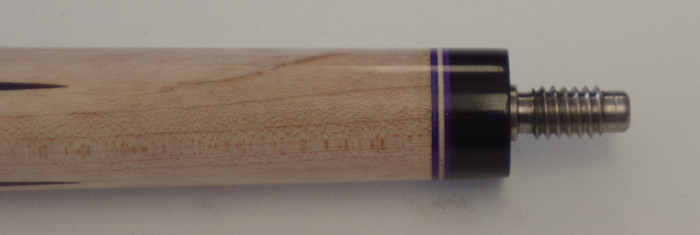First Cue : #1

I changed the dimensions of the standard cue a little in this first attempts. A standard butt has a constant taper from its joint to butt cap. I changed this a little and put a steeper taper from the joint to the start of the handle, A-joint. Then no taper for the rest of the cue. A constant diameter for the handle made sense to me. The forearm is 12", the wrap area 12.5" and 4.5" from the wrap to the end of the butt cap, 29" overall. The diameter at the joint is determined by the shaft which is 21.3mm (.878") and the diameter of the handle was 1.18".
For this first attempt I went with relatively inexpensive materials. I chose maple blanks for the forearm and handle. For the points and butt sleeve I used Home Depot walnut. The rings and veneers are made for pool cues of colored poplar. The poplar rings are all 0.40" thick while the veneers are all 0.30". The black rings are a fiber filled plastic. The collars are made from black and natural T-34, a plastic. I will confess I have no feel for how this combination will play. I'm not sure I could tell once it is built how well it plays. I did do drawings and a solid model before starting. The model showed the weight, with small weight bolt, to be 19oz with a CG some 19" from the butt. From what I could find this is about right.
This description was getting long so I've broken it into four sub-sections.
Summary
The cue came out better than I expected. Being my first try I expected more difficulties and major screw ups. Here are some pics of the finished cue.




The cue plays well as far as I can tell. That's mainly the shaft, but I'm very pleased with it.
The only major problem I can see, as mentioned in the forearm section, is what I believe to be a separation of the point veneers. You can see in the pic below that the point shown doesn't have cleanly fitting veneers, there is a dark streak at the end of the point. I believe this is a separation of the veneers filling with epoxy. I think I know what caused this, and I have a work around for the next try.

Very satisfying results and a good playing cue though. Much nicer to play with than the cheap cue I have been using, but this could be mental.
When I went down this road I ordered enough material for three cues anticipating the first would be a total loss. Two built with simple less expensive woods (maple and walnut) and one with birdseye maple and ebony. My plan is to build up two more cues. Cue #2 to follow the format of Cue #1 as a break cue and Cue #3, with the more exotic woods, as a playing cue. We'll see how it goes.
So far it's been a great project. No idea if I'll make more than these 3. Time will tell.
Cues : Main Page CandyCane Cue